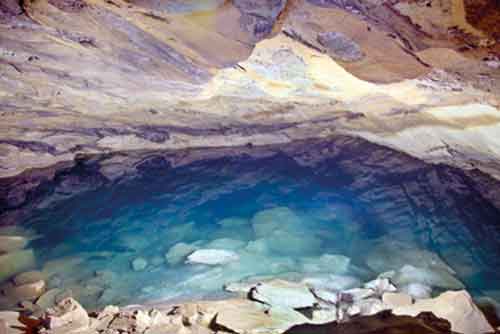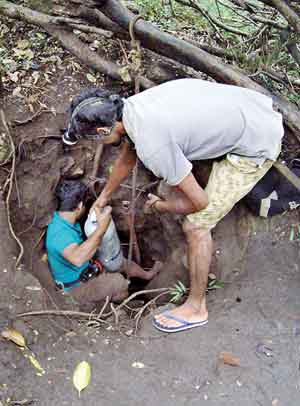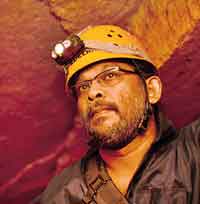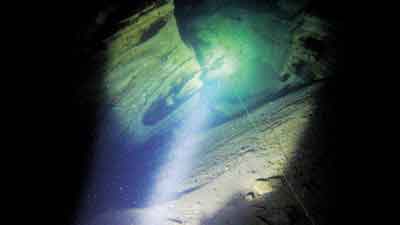Down a rabbit hole and the magic unfolds

Linked to the Ravana legend: Nil Diya Pokuna. Pix courtesy of the documentary Deep into Earth
You can easily put up a five-storey building inside it. At its widest areas, it is about 75 metres in length, 72 metres in width and 16 metres in height,” is how underwater explorer Dharshana Jayawardena recollects his encounter with a massive underground cave chamber. It is inside the belly of a mountain range, on the way underground to a mysterious lake called Ravana’s Nil Diya Pokuna off Ella, a place entwined with the Rama-Sita legend. The expert diver, the first to have discovered and explored in this country, an underwater cave system lying beneath this beautiful lake, tells the Sunday Times that it was simply “an amazing sight to behold”.
The Nil Diya Pokuna, lying 80 metres deep inside a mountain cave in Karandagolla can be accessed via two independent entrances, of which the better-known one is situated in a forest reservation in the area, while a villager, R.M. Meththananda, then discovered about three years ago a second entrance on a private property. Although many had reached Nil Diya Pokuna via both ways, Dharshana was the first to dive into this lake recently and discover a hitherto unknown underwater cave system.
An experienced technical Scuba diver known for his shipwreck discoveries and lucidly documented work, Ghosts of the Deep- Diving the shipwrecks of Sri Lanka, Dharshana had until then heard of Nil Diya Pokuna through word of mouth and was intrigued by the possibility that the caves could extend underwater. “After completing three cave diving courses and earning the Full Cave Diver certification in Thailand, exploring about 12 challenging caves, I was looking for underwater caves here at home when I heard of the Nil Diya Pokuna,” recollects Dharshana and immediately set about exploring it with the help of Meththananda.

Down the rabbit hole: Dharshana begins his descent and right, ready to dive
The journey to the underground lake begins with a half-an-hour hike into the jungle. For Dharshana and his team, it was an arduous undertaking. It required four people to carry his special cave-diving gear across the ‘treacherous terrain’ as he describes. “If not for Meththananda and his support crew, I couldn’t have managed these expeditions,” he adds. After rappelling down the ‘Rabbit Hole’ (as Dharshana calls the steep tunnel at the start of the cave, named after Alice in Wonderland) using a rope, it is simply a thriller movie, which unfolds! The one-hour’s trek inside the mountain, swathed in complete darkness, down rocks, slippery slopes and narrow restrictions brings one to a dry massive central chamber. Beyond this chamber, another half-an-hour hour trek down the cave takes you to the Nil Diya Pokuna. It is about 30 metres in length and about 10-15 metres wide at its widest point as Dharshana says. “As it is deep within a mountain cave, devoid of sunlight, there are no observable living things at the lake level. Further up close to the entrance one can observe large numbers of bats, moths, grass hoppers and spiders.”
Legend has it that Sita, the beautiful consort of Rama, the Prince of Ayodhya, was abducted by Ravana, the king of Lanka, in an act of revenge. was held captive in the island of Lanka and, according to local folklore, Sita was brought to Nil Diya Pokuna to bathe. Some of the villagers even believe that Ravana’s body still lies close by, buried here after he was slain by Rama’s spear in the battle to reclaim his beloved Sita. “Many warned me that a divine power will stop me from exploring the cave as the place is shrouded in myth,” says Dharshana with a smile.
The chilly, 23C degree, deep waters of this liver-shaped pool were so intense that it “numbed my mind” he recalls. “Unlike the normal ocean temperature which is about 28C to 29C, the waters of Nil Diya Pokuna were biting cold as the pond lies 776m above sea level in a mountain range and the dive required a thicker exposure protection suit than what I usually use in the ocean.” With just torchlight as the only source of illumination in the otherwise ‘pitch black surroundings’, Dharshana initially explored the left side of the lake and found an underwater entrance that sloped down into a wide passage.
About 60 metres down this track, a narrow pass, which he later named, Jatayu pass ( after a giant king of vultures that attacked Ravana when he kidnapped Sita) greeted him with many challenges. “One of my breathing regulators started failing, the cold became intense, and my exhalation air bubbles hit the cave roof and it started falling on me in a flurry of pieces and the visibility just went to zero. Also, I got entangled in my guideline (a reel of thin braided nylon line used by cave divers to find their way back out of an underwater cave) and I had to cut it and repair it before I could come back. In this dive I had reached a maximum depth of 21m and I was underwater for 44 minutes and as a result a permanent guideline was laid up to the pass where I had problems.”
 After the initial dive to the caves came three more dive expeditions. Dharshana named the left underwater entrance as Ravana Maga and the right entrance as Sita Maga. In the second dive expedition, he managed to explore Sita Maga comprehensively, installing another permanent guideline. In his third dive expedition, Dharshana swam down Ravana Maga and beyond the tricky Jatayu pass only to come across Sita Maga after a while! It was an ‘Eureka moment’ for Dharshana to be able to connect these two underwater pathways beneath the Nil Diya Pokuna. “It was amazing to discover one single big underwater cave system which could be accessed by two different sides,” he says.
After the initial dive to the caves came three more dive expeditions. Dharshana named the left underwater entrance as Ravana Maga and the right entrance as Sita Maga. In the second dive expedition, he managed to explore Sita Maga comprehensively, installing another permanent guideline. In his third dive expedition, Dharshana swam down Ravana Maga and beyond the tricky Jatayu pass only to come across Sita Maga after a while! It was an ‘Eureka moment’ for Dharshana to be able to connect these two underwater pathways beneath the Nil Diya Pokuna. “It was amazing to discover one single big underwater cave system which could be accessed by two different sides,” he says.
In his fourth dive, he explored much further beyond Jatayu pass, installing permanent guidelines and discovered that the cave continues with no visible end in sight, indicating perhaps that this cave could continue underwater for even many hundreds of metres more. The caves are completely devoid of marine life. “It is breathtaking to see undisturbed areas of the underwater cave. It is a place of great beauty and tranquility. However the water seemed sterile except for a small worm found at the surface,” he said.
With the footage acquired in these expeditions, Dharshana and his team are now producing an exciting exploration documentary called Deep into Earth which will be released next year. Another notable result of the Deep into Earth project was that, one key expedition member, Manjula Wijeyaratne was able to acquire precise barometric and laser measurements of the dry part of the cave and create invaluable detailed maps of the terrain. Deep into Earth also received valuable input from Dr. Wasantha Sena Weliange who also accompanied the team on the fourth expedition to the cave.
Cave diving is one of the most dangerous forms of Scuba diving and requires a diver to be in a situation where he/she cannot immediately ascend to safety in case of an emergency. “The only way back to the surface is the way you came back, the reason why I had to use a guideline. It is the only reliable way to come back without being disoriented and losing your way. By laying permanent guidelines, future exploration will be easier as subsequent cave divers can now simply follow the line,” he notes. This, as he further explains requires a special equipment configuration that has backups including a minimum of two scuba tanks and multiple torches. Cave diving may also require decompression diving as a diver goes deep and can’t come straight back up but needs to stop at different levels to decompress.
| A cave like no other in Sri Lanka | |
 Dr. Wasantha Weliange Speaking to the Sunday Times, Senior Lecturer from the Department of Zoology of the Faculty of Applied Sciences, University of Rajarata, Dr. Wasantha Sena Weliange who is also an authority on the ecology and functions of streams and rivers in Sri Lanka notes, that in his cave exploration experience in the country, Ravana Cave is so far the largest. “It’s enormous compared to others. On the floor of the Ravana cave there are polygonal rock boulders ranging from about 1 metre to 4-5 metres. They are all made of common rock types like gneiss. The cave floor is not flat, but has the slope similar to the outside landscape. Another interesting factor is the Olympic size pool which is found inside. As there is no wind inside the cave the surface of the water is always still, which you cannot see anywhere else.”  The tricky Jayatu pass The formation of Nil Diya Pokuna as Dr. Weliange explains is interesting. The earthly materials which surround the cave are porous. When it rains a portion of the rain flows along the surface downwards and a portion is soaked to the soil. Soaked water seeps through the soils due to gravity and this drops to the void from its roof. This accumulation of water has created the pool. To determine the age of a cave, the age of the deposits found in a cave are analyzed says the scholar. “For example; inside the caves there are deposits which are known as speleotherms, or galmal in lay terms which means stony sprouts. There are two major types of speleotherms known as stalagmite and stalactite. Stalagmite is commonly called Hiri Temba and stalactites are known as Hiri Lamba. Those speleotherms started growing after the formation of the underground void, many thousands of years ago due to landslides during the last glaciation. If we determine the age of the speleotherm then it is equal to the age of the cave. There are many techniques to determine the age of those things. According to our logic, the Ravana cave could be about 25000 years old or little less.”
|


